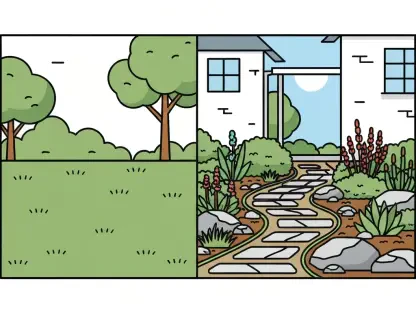In the heart of Scotland’s bustling commercial property market, a significant shift is unfolding as investors recalibrate their strategies to focus on quality rather than sheer volume, reflecting a cautious yet calculated response to economic uncertainties. This transformation, driven by a preference for premium assets in prime locations, mirrors the growing need for modern, amenity-rich spaces that cater to contemporary business demands across major urban centers like Edinburgh and Glasgow. The emphasis on high-value transactions signals a maturing market where strategic positioning and robust environmental, social, and governance (ESG) credentials are becoming non-negotiable. This trend not only highlights a discerning approach among investors but also underscores the evolving investment patterns setting a new benchmark for market resilience in the Scottish property landscape.
Urban Centers Lead with High-Value Transactions
The commercial property scene in Scotland’s major cities is experiencing a remarkable upswing in deal values, underscoring the shift toward quality investments. During the first half of this year, Scotland recorded 59 transactions with an average deal size of $12.7 million, a substantial increase compared to historical averages. Edinburgh stands out with an impressive 84% surge in average deal size, reaching $26.3 million, driven by a clear preference for top-tier properties in central locations. Glasgow, too, has seen a notable rise, with average deal sizes climbing 38% to $15.5 million, reflecting strong investor confidence in well-positioned assets. However, this growth is not uniform, as Aberdeen reports a modest 4% increase to $7.3 million, tempered by past large-scale transactions. This disparity across cities illustrates how location and asset quality are critical drivers in attracting significant capital, with urban hubs emerging as the focal points of investment activity.
Beyond the headline figures, the trend in urban centers reveals a deeper alignment between investor priorities and market dynamics. The rise in prime rents, with Edinburgh reaching $46 per square foot and Glasgow at $41.50 per square foot, indicates robust demand for high-quality spaces that offer flexibility and access to amenities. Approximately two-thirds of recent property take-up in Scotland involved new or Grade A accommodations, signaling that occupiers are equally selective, favoring environments that enhance productivity and sustainability. This convergence of investor and occupier interests is fostering a competitive market where only the best-located and best-equipped properties secure attention. As a result, the focus on premium assets in city centers is not merely a passing trend but a strategic response to the evolving needs of businesses navigating a complex economic landscape.
Challenges in Peripheral Markets
While Scotland’s major cities thrive, the property market outside these urban strongholds paints a starkly different picture, grappling with significant declines in investment activity. In regions beyond Edinburgh, Glasgow, and Aberdeen, average deal sizes have plummeted by 52%, dropping to just $3.2 million from a previous benchmark of $6.6 million. Overall investment volumes in these areas have also taken a severe hit, falling from a five-year annual average of $341 million to a mere $38 million in the first six months of the current year. This sharp downturn reflects a broader investor hesitance to commit capital to less central locations where demand for commercial spaces is weaker. The challenges in these peripheral markets highlight a polarized landscape where the allure of prime urban assets overshadows opportunities in less prominent regions.
The struggles in peripheral markets are compounded by a lack of occupier interest in spaces that fail to meet modern standards or offer strategic advantages. Unlike the vibrant city centers where premium properties dominate transactions, these outlying areas often contend with outdated infrastructure and limited access to key amenities, deterring both investors and businesses. This growing divide suggests that without targeted interventions or incentives to boost attractiveness, peripheral regions risk being sidelined in the broader Scottish property narrative. The focus on quality, while beneficial for urban hubs, inadvertently widens the gap, leaving smaller markets in need of innovative strategies to regain relevance. As the market continues to prioritize prime locations, the disparity serves as a reminder of the nuanced challenges facing a geographically diverse investment environment.
Future Outlook for Strategic Investments
Looking ahead, the emphasis on quality in Scotland’s commercial property sector appears poised to endure, shaping investment decisions for the foreseeable future. Industry experts anticipate that the preference for high-value, strategically located assets will remain a defining characteristic, particularly as businesses continue to seek modern, sustainable spaces in prime urban areas. Despite a relatively subdued start to the year due to macroeconomic and geopolitical uncertainties, activity for the right type of properties has held steady, offering a glimmer of optimism. There is hope that as global conditions stabilize, a broader uptick in market engagement will emerge, potentially benefiting a wider range of assets and locations over the coming months.
Reflecting on the past, the strategic pivot toward premium investments in key cities demonstrated a resilient approach among Scottish investors. The significant growth in deal values and prime rents in urban centers underscored a market adapting to both caution and opportunity. Moving forward, stakeholders are encouraged to explore ways to bridge the gap between thriving city hubs and struggling peripheral regions, possibly through innovative development or policy support. The enduring focus on quality has set a strong foundation, and the challenge ahead lies in extending this momentum to create a more balanced and inclusive property market across Scotland.









